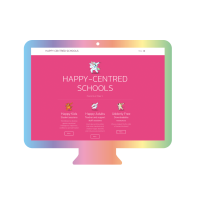10 Top Tips for Teaching Virtually

Teaching is tough enough without having to do it virtually. With blank screens rather than enthusiastic faces and radio silence instead of enthusiastic responses, it’s about as far away from traditional teaching as you can get. No wonder your motivation is low.
Here at Laughology, we deliver virtual sessions a lot and even we’ve found some of it difficult. Put children and young people into the mix and it’s a tough crowd - and our background is in standup! But through experience we know what works, so to help you we’ve put together our ten top tips for teaching virtually.
1. Engagement first, content later
Spend some time upfront having fun and engaging your children. This time will not be wasted. It’s as important to switch on their brains in the virtual classroom as it is in the real classroom. Use the first few minutes to deliver something light and fun.
Encourage them to use the chat function to answer or, if using breakout rooms, give them questions and allow them to confirm and come back to answer. Some good starter activities are:
- Five ways to… (anything can go here) end a bad date, exercise a pet hamster, make a giraffe cry. You get the drift
- Family fortunes - have a google you’ll get some set questions and these are fun
- Best animal impression
- Best lockdown entertainment so far.
You might not get everyone involved, but at least your more extroverted pupils can play to the audience and the less extroverted children will be entertained.
2. Bring in activities that involve movement
Get them to find things from around the house that connect to the theme of your session. This gets them thinking in a different way and can work with anything. For example: One minute to find something in the house that connects to photosynthesis but it can’t be a plant.
Why not set the question for the next lesson so they can prepare and bring a show and tell? If you can’t have cameras on, encourage them to send a photo so you can screen share. Some students might feel safer doing this in a group. Breakout rooms make this possible and students can connect for homework, or between lessons, to plan.
3. Get creative for encouraging a response
Mix up responses. Use chat, verbal and visual. Have a quick fire round where you can have statements that are true or false. For visual responses, use thumbs up, thumbs down or don’t know with arms crossed. Use this as a starting point for encouraging conversations about why they answered true or false.
4. Get the brain working differently
Learning isn’t just about sharing knowledge, it’s about exploring how that knowledge works and what it means in your world. At Laughology, we like to have fun with learning and encourage a different way of thinking about information. We call these Brain Burps.
A Brain Burp normally starts with:
- What if?
- Who would?
- Where would?
For example: What if a square and triangle had a fight? Who would win?
Simply encourage them to answer in the chat with ‘square’ or ‘triangle’, but then ask them why. This encourages the brain to explore the facts in a different way.
Another example is: Where would King Henry VIII take Ann Boleyn on a date? You can do this in groups and set the topic for kids to make up their own Brain Burps for each other.
5. For fun allow children to rename themselves
As long as you create some boundaries, this can be a fun way of engaging your group. Set a topic their new name has to link to, you can do this before the session and during the session ask why their new name links to the topic.
6. Points make prizes
Give you points in your session for right answers and at the end of the week give out a prize for first, second and third place. To encourage everyone to join in, you can create online teams. Gamification really works too. The minute children and young people know it’s a game, engagement goes through the roof
7. Healthy debate
Encourage learning through debate. Use breakout rooms to create debate groups. Share a statement but don’t say whether it’s true or false, or right or wrong. It can be as simple as, ‘the TV should be off when eating your dinner’. In their groups, they all have to agree/disagree and come up with a valid argument as to why.
When they come back to the rest of the group they can share their points collectively
8. Give children roles
We all love to feel important, even virtually. Giving children roles is a classic way of encouraging engagement. However make your roles creative. You might have:
- The Speakers. Other pupils can email/chat to them and they can share points.
- The Mini Teacher – it might be the mini teachers role to feedback to you or help you in the session.
Having speaking roles in a session helps to distribute the talk and take the pressure off you. Kids love responsibility too. You might want to give out roles before the session to give them time to prepare.
9. Best things come in little bursts
Teaching online means that children have even shorter attention spans. Plan short sharp sessions. Thirty minutes is a really good time to plan for. Within that time you should structure content to flow in a way that includes a little bit of theory, activities, breakouts/group work and plenary.
If you want to do longer sessions, set a task for children to do together or by themselves and then ask them to come back and share.
10. Energy counts
We know it’s really hard to stay motivated when you’re getting nothing back. Hopefully some of these tips will help. Your energy is important too, so make sure you look after yourself by eating right and taking screen breaks.
Try and stand up when you present to the class too. You’ll feel more in control and it will change your energy levels. If you don’t have a standing desk, use an ironing board and your laptop. It’s height adjustable so should work.
If you would like any more top tips or advice, let us know and we’ll do our best to create content that you need.
- Created on .












































